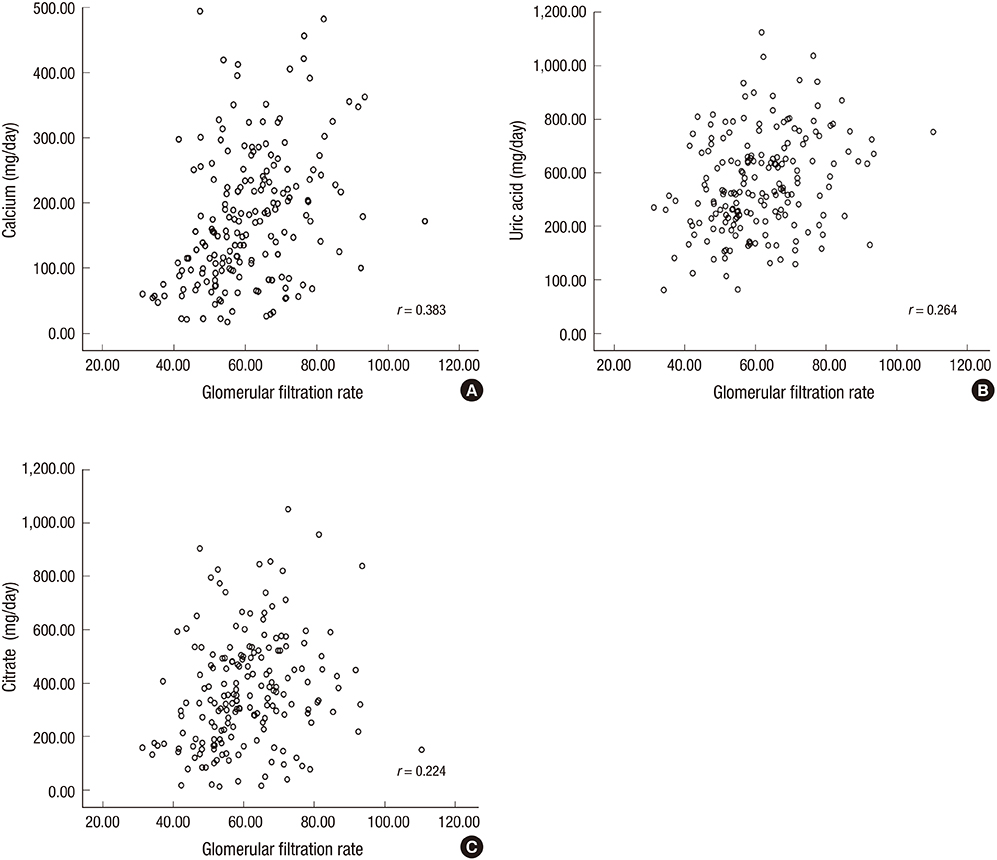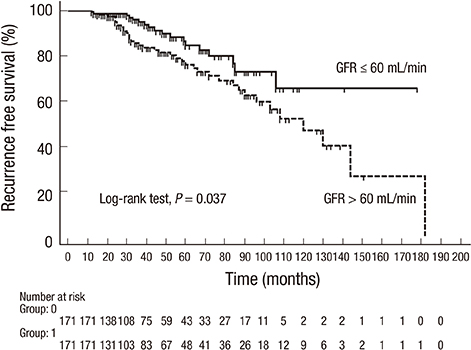J Korean Med Sci.
2014 Aug;29(8):1132-1137. 10.3346/jkms.2014.29.8.1132.
Effect of Renal Insufficiency on Stone Recurrence in Patients with Urolithiasis
- Affiliations
-
- 1Department of Urology, College of Medicine, Chungbuk National University, Cheongju, Korea. lscuro@chungbuk.ac.kr
- KMID: 2129610
- DOI: http://doi.org/10.3346/jkms.2014.29.8.1132
Abstract
- The study was designed to assess the relationship between glomerular filtration rate (GFR) and urinary stone-forming constituents, and to assess the effect of renal insufficiency on stone recurrence risk in first stone formers (SF). Baseline serum creatinine levels were obtained, and renal insufficiency was defined as creatinine clearance < or =60 mL/min (Cockroft-Gault). This retrospective case-control study consists of 342 first SF; 171 SF with normal renal function were selected with 1:1 propensity scores matched to 171 SF with renal insufficiency. Urinary metabolic evaluation was compared to renal function. GFR was positively correlated with urinary calcium, uric acid, and citrate excretion. Subjects with renal insufficiency had significantly lower urinary calcium, uric acid, and citrate excretion than those with normal renal function, but not urine volume. With regard to urinary metabolic abnormalities, similar results were obtained. SF with renal insufficiency had lower calcium oxalate supersaturation indexes and stone recurrence rates than SF with normal renal function. Kaplan-Meier curves showed similar results. In conclusion, GFR correlates positively with urinary excretion of stone-forming constituents in SF. This finding implies that renal insufficiency is not a risk factor for stone recurrence.
Keyword
MeSH Terms
Figure
Reference
-
1. Knoll T, Schubert AB, Fahlenkamp D, Leusmann DB, Wendt-Nordahl G, Schubert G. Urolithiasis through the ages: data on more than 200,000 urinary stone analyses. J Urol. 2011; 185:1304–1311.2. Knoll T. Epidemiology, pathogenesis, and pathophysiology of urolithiasis. Eur Urol Suppl. 2010; 9:802–806.3. Lotan Y. Economics and cost of care of stone disease. Adv Chronic Kidney Dis. 2009; 16:5–10.4. Clark JY, Thompson IM, Optenberg SA. Economic impact of urolithiasis in the United States. J Urol. 1995; 154:2020–2024.5. Matlaga BR, Jansen JP, Meckley LM, Byrne TW, Lingeman JE. Economic outcomes of treatment for ureteral and renal stones: a systematic literature review. J Urol. 2012; 188:449–454.6. Marangella M, Bruno M, Cosseddu D, Manganaro M, Tricerri A, Vitale C, Linari F. Prevalence of chronic renal insufficiency in the course of idiopathic recurrent calcium stone disease: risk factors and patterns of progression. Nephron. 1990; 54:302–306.7. Worcester EM, Parks JH, Evan AP, Coe FL. Renal function in patients with nephrolithiasis. J Urol. 2006; 176:600–603.8. Worcester E, Parks JH, Josephson MA, Thisted RA, Coe FL. Causes and consequences of kidney loss in patients with nephrolithiasis. Kidney Int. 2003; 64:2204–2213.9. Gillen DL, Worcester EM, Coe FL. Decreased renal function among adults with a history of nephrolithiasis: a study of NHANES III. Kidney Int. 2005; 67:685–690.10. Chaussy C, Schüller J, Schmiedt E, Brandl H, Jocham D, Liedl B. Extracorporeal shock-wave lithotripsy (ESWL) for treatment of urolithiasis. Urology. 1984; 23:59–66.11. Rule AD, Bergstralh EJ, Melton LJ, Li X, Weaver AL, Lieske JC. Kidney stones and the risk for chronic kidney disease. Clin J Am Soc Nephrol. 2009; 4:804–811.12. Musso CG, Juarez R, Vilas M, Navarro M, Rivera H, Jauregui R. Renal calcium, phosphorus, magnesium and uric acid handling: comparison between stage III chronic kidney disease patients and healthy oldest old. Int Urol Nephrol. 2012; 44:1559–1562.13. Kadlec AO, Greco KA, Fridirici ZC, Gerber D, Turk TM. Effect of renal function on urinary mineral excretion and stone composition. Urology. 2011; 78:744–747.14. Eknoyan G, Levin NW. K/DOQI clinical practice guidelines for chronic kidney disease: evaluation, classification, and stratification. Am J Kidney Dis. 2002; 39:S1–S266.15. Cockcroft DW, Gault MH. Prediction of creatinine clearance from serum creatinine. Nephron. 1976; 16:31–41.16. Lifshitz DA, Shalhav AL, Lingeman JE, Evan AP. Metabolic evaluation of stone disease patients: a practical approach. J Endourol. 1999; 13:669–678.17. Ogawa Y, Hatano T. Comparison of the Equil2 program and other methods for estimating the ion-activity product of urinary calcium oxalate: a new simplified method is proposed. Int J Urol. 1996; 3:383–385.18. Tiselius HG. Aspects on estimation of the risk of calcium oxalate crystallization in urine. Urol Int. 1991; 47:255–259.19. Bryant M, Angell J, Tu H, Goodman M, Pattaras J, Ogan K. Health related quality of life for stone formers. J Urol. 2012; 188:436–440.20. Lim GS, Jang SH, Son JH, Lee JW, Hwang JS, Lim CH, Kim DJ, Cho DS. Comparison of non-contrast-enhanced computed tomography and intravenous pyelogram for detection of patients with urinary calculi. Korean J Urol. 2014; 55:120–123.21. Goel MC, Ahlawat R, Kumar M, Kapoor R. Chronic renal failure and nephrolithiasis in a solitary kidney: role of intervention. J Urol. 1997; 157:1574–1577.22. Sairam K, Scoffone CM, Alken P, Turna B, Sodha HS, Rioja J, Wolf JS Jr, de la Rosette JJ. CROES PCNL Study Group. Percutaneous nephrolithotomy and chronic kidney disease: results from the CROES PCNL Global Study. J Urol. 2012; 188:1195–1200.23. Jungers P, Joly D, Barbey F, Choukroun G, Daudon M. ESRD caused by nephrolithiasis: prevalence, mechanisms, and prevention. Am J Kidney Dis. 2004; 44:799–805.24. Lang F. Renal handling of calcium and phosphate. Klin Wochenschr. 1980; 58:985–1003.25. Coresh J, Astor BC, Greene T, Eknoyan G, Levey AS. Prevalence of chronic kidney disease and decreased kidney function in the adult US population: third National Health and Nutrition Examination Survey. Am J Kidney Dis. 2003; 41:1–12.26. Coresh J, Selvin E, Stevens LA, Manzi J, Kusek JW, Eggers P, Van Lente F, Levey AS. Prevalence of chronic kidney disease in the United States. JAMA. 2007; 298:2038–2047.27. Levey AS, Coresh J. Chronic kidney disease. Lancet. 2012; 379:165–180.28. Kim IY, Hwang IH, Lee KN, Lee DW, Lee SB, Shin MJ, Rhee H, Yang B, Song SH, Seong EY, et al. Decreased renal function is an independent predictor of severity of coronary artery disease: an application of gensini score. J Korean Med Sci. 2013; 28:1615–1621.29. Paryani JP, Ather MH. Improvement in serum creatinine following definite treatment of urolithiasis in patients with concurrent renal insufficiency. Scand J Urol Nephrol. 2002; 36:134–136.30. Gupta M, Bolton DM, Gupta PN, Stoller ML. Improved renal function following aggressive treatment of urolithiasis and concurrent mild to moderate renal insufficiency. J Urol. 1994; 152:1086–1090.



